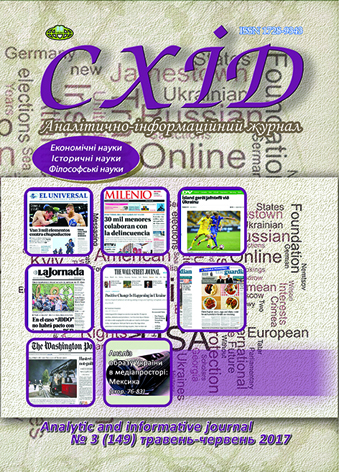Phenomenon of gold and diamond rushes as territorial, mining and socio-cultural development of continental spaces of North America and Australia (Part I)
DOI:
https://doi.org/10.21847/1728-9343.2017.3(149).108121Keywords:
gold rush, free miners, panning method, California, Yukon, Alaska, Queensland, Bendigo, BallaratAbstract
This series of articles systematizes the events of settlement and economic development of vast spaces of North America, Australia, South Africa and North Asia, which are related to the movement of gold and diamond hunters (gold and diamond rushes). A chronological survey of the events is offered, the general phenomenon analyzed as well as specific aspects of its historical, mining, geological and organizational constituents covered. The material is divided into three separate but thematically united parts which describe the phenomenon of gold rush-spontaneous large-scale gold mining at newly discovered deposits in remote (for Europeans) parts of the world in the second half of the 19th century - the early 20th century.
The impact of gold rushes in North America and Australia on the processes of global economic and financial transformations is shown. Large outputs resulted in setting a monetary gold standard which had been in place up to World War I: a wide turnover of gold coins, displacement of silver which began to act as token money as well as free exchange of paper money for gold coins. The above contributed to a sustainable development of world money relations which gave rise to a global financial system in the modern sense; a significant banks' influence on economic transformations as well as establishment of international centers for financial capital. Huge gold reserves were purposefully accumulated in the USA which, extracting an ample quantity of gold in its territory, bought up a considerable part of the world gold output, which eventually secured the key status of the American currency in world trade. Extracted gold played a key role in provision of financial resources for large-scale industrial development of the industrial epoch. Numerous migrations of working people from gold mining sites promoted the development and settlement of remote territories as well as the utilization of their natural resources in the global economic development.Downloads
References
Andrist, Ralph K. (2015), The Gold Rush, New Word City, 145 р. (eng)
Reeves, Keir & Frost, Lionel & Fahey, Charles (2010). Integrating the Historiography of the Nineteenth-Century Gold Rushes. Australian Economic History Review. 50 (2): 111. doi:10.1111/j.1467-8446.2010.00296.x
Micheloud, François (2004). The Crime of 1873: Gold Inflation this time. FX Micheloud Monetary History. Available at: http://www.micheloud.com/FXM/MH/Crime/Gold.htm
Malone, Michael P. & Roeder, Richard B. & Lang, William L. (1991), Chapter 4, The Mining Frontier. Montana: a history of two centuries (Rev. ed.). Seattle, WA: University of Washington Press. pp. 64-91. Available at: https://books.google.com.ua/books?id=p-P59FkOPg0C&printsec=frontcover&redir_esc=y#v=onepage&q&f=false
North, Michael (1994), Das Geld und seine Geschichte. C. H. Beck, München, S. 121 (deutch).
Brands, H. W. (2003), The age of gold: the California Gold Rush and the new American dream, New York. Available at: https://www.amazon.com/Age-Gold-California-American-Dream/dp/0385720882
Berton, Pierre (2001), Klondike: The Last Great Gold Rush, 1896-1899. Random House of Canada, 496 p. (eng).
Marfunin, A.S. (1987), The history of gold, Nauka, Moscow, 248 p. (rus).
Anikin, A.V. (1984), Gold, International Relations, Moscow, 320 p. (rus).
Lokerman, A.A. (1978), The riddle of Russian gold, Nauka, Moscow, 144 p. (rus).
Alekseev, I.S. (2008), Gold. Diamonds. People KNORUS, Moscow, 600 p. (rus).
Gayko, G & Biletsky, V. (2015). Mining constituent of the period of great geographic discoveries. Skhid, no. 3(135), DOI: 10.21847/1728-9343.2015.3(135).45747.
Biletsky, V. & Gayko, G (2006). Chronology of mining in the countries of the world, Donetsk branch of NTSh, Editorial of Mining Encyclopedia, Donetsk, 224 p. (ukr).
Gayko, G & Biletsky, V. (2015), Mining in the history of civilization, Publishing House of Kyiv-Mohyla Academy, Kyiv, 486 p. (ukr).
Downloads
Published
How to Cite
Issue
Section
License
Copyright (c) 2017 Gennadiy Gayko, Volodymyr Biletsky

This work is licensed under a Creative Commons Attribution-NonCommercial-NoDerivatives 4.0 International License.
1. Authors bear responsibility for the accuracy of facts, quotations, numbers and names used.
2. Manuscripts are not sent back.
3. The publisher does not always agree with the authors' opinion.
4. The authors reserve the right to authorship of the work and pass the first publication right of this work to the journal under the terms of a Creative Commons Attribution-NonCommercial-NoDerivatives 4.0 International License. This license allows others to distribute (copy) the published work for non-commercial purposes, provided there is mandatory attribution to its authors and a link to the first publication in our journal.
5. The authors have the right to conclude separate supplement agreements that relate to non-exclusive work distribution in the form in which it has been published by the journal (for example, to upload the work to the online storage of the journal or publish it as part of a monograph), provided that the reference to the first publication of the work in this journal is included.

